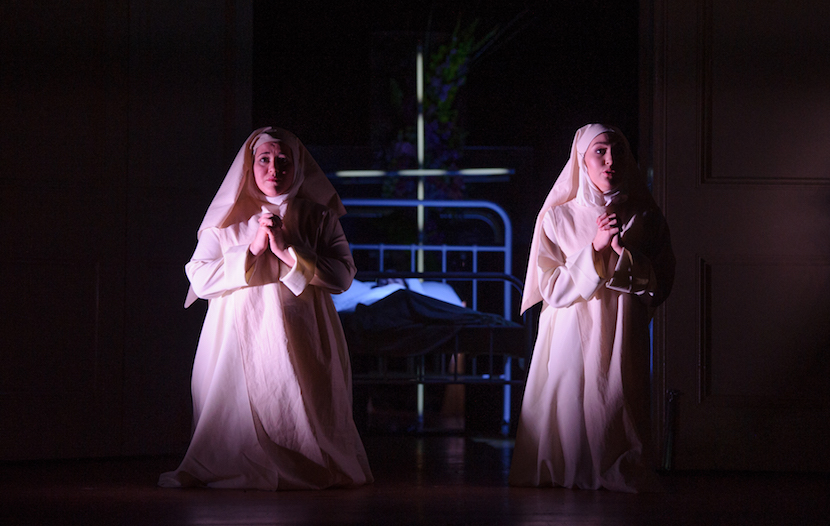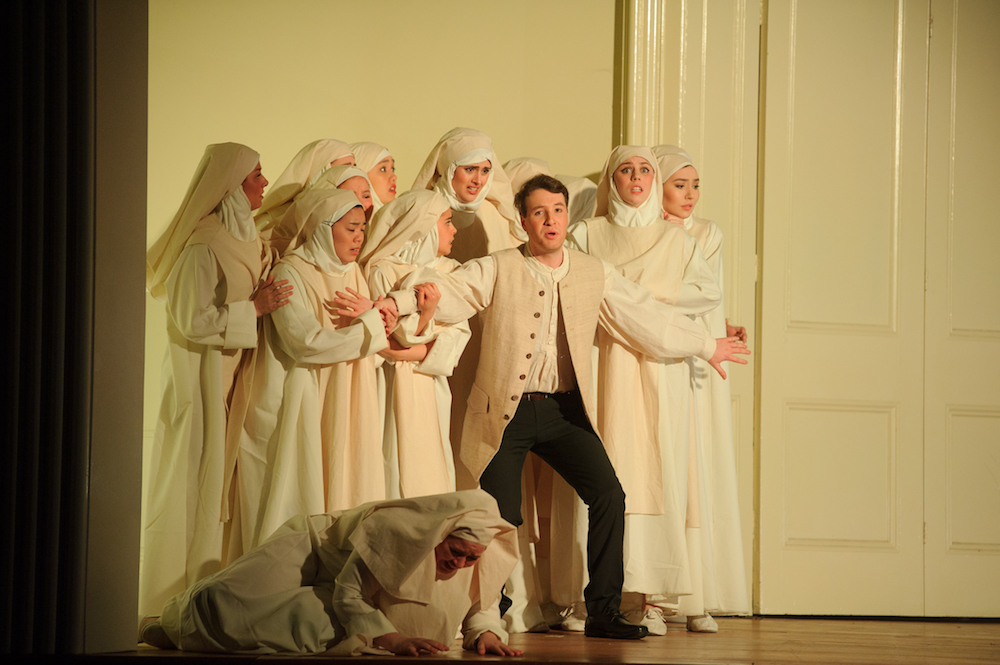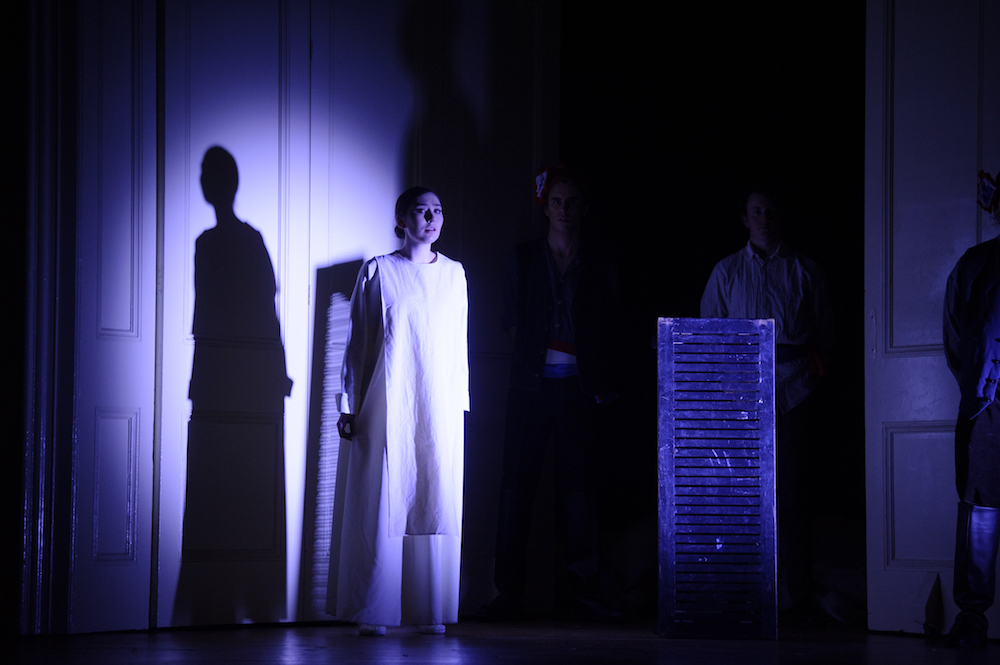“What an extraordinary performance,” said an audience member behind me in awe, as the lights went up in the Rosina Hall at Melbourne’s Abbotsford Convent.
It was interval on opening night at the Melbourne Conservatorium of Music’s ambitious production of Poulenc’s tragic opera, Dialogues des Carmélites. This rarely-performed gem, which debuted in Milan in 1957, follows the tragic true story of 16 Carmelite nuns who lost their lives to the guillotine during the Reign of Terror in the French Revolution.
 Teresa Ingrilli and Amelia Wawrzon in Melbourne Conservatorium of Music’s Dialogues of the Carmelites. Photo © Sarah Walker
Teresa Ingrilli and Amelia Wawrzon in Melbourne Conservatorium of Music’s Dialogues of the Carmelites. Photo © Sarah Walker
This performance was a triumph. Not only did it successfully showcase the talent of some of Melbourne’s finest developing artists, but through considered choices in production it paid respectful homage to the nuns who sacrificed their lives for their faith.
There were solid performances from all leads across the board. Due credit must be given to Teresa Ingrilli as the anxious protagonist Blanche de la Force, and Rebekah Luise as Mother Marie de l’Incarnation. Both managed to sustain character focus and vocal consistency throughout their ample time on stage. Amelia Wawrzon was also strong as Soeur Constance, and proved a perfect foil of frivolity to Blanche’s seriousness. Thomas Harvey as Blanche’s brother, Chevalier de la Force was another foil, his bright tenor ringing through in a desperate attempt to convince Blanche to leave the order.
But the standout performance was Heather Fletcher’s portrayal of the dying Madame de Croissy, Prioress of the order of the Carmelites. It is a difficult balancing act to portray weakness and strong desperation side-by-side convincingly while maintaining the necessary vocal sound and power required. But Fletcher managed this with aplomb, delivering sensitive singing and committed acting that ensured the audience felt every the desperation and fear of de Croissy’s final moments, spent in delirium.
 Benjamin Glover and the cast of Melbourne Conservatorium of Music’s Dialogues of the Carmelites. Photo © Sarah Walker
Benjamin Glover and the cast of Melbourne Conservatorium of Music’s Dialogues of the Carmelites. Photo © Sarah Walker
The score for this opera is not what audiences might expect from a work composed in the 1950s. In fact, Poulenc once apologised for the music, saying, “You must forgive my Carmelites – it appears they can only sing tonal music”. But this is as it should be. Discomfort can be found in the avant-garde, but what really strikes fear into us all is when the familiar fails to be of comfort. This is demonstrated time and again in the score, and illustrated well in this production through the sensitivity of the performers. The most familiar yet haunting music was the sacred choral strains of the nuns. This is music which usually serves as a salve, but in this case became more and more distressing as the nuns’ situation deteriorated into terror.
The orchestra used for this performance was a nod to the rise of the wind band during the French Revolution. Made up only of winds, brass and percussion, with piano filling in the string parts, they delivered an expressive tone colour which was a pleasure to hear outside the realm of symphonic wind band repertoire. Occasionally some intonation issues in the upper winds marred the performance, and, as can be a danger with this kind of ensemble, some of the louder, more intense moments overwhelmed the lighter voices in the cast.
 Amelia Wawrzon in Melbourne Conservatorium of Music’s Dialogues of the Carmelites. Photo © Sarah Walker
Amelia Wawrzon in Melbourne Conservatorium of Music’s Dialogues of the Carmelites. Photo © Sarah Walker
This production was also a triumph in intelligent set and lighting design. Creative director Jane Davidson and designer Matthew Adey demonstrated that even in a genre known for sumptuous, extravagant sets, less can most certainly be more. As the performance space was more akin to a church hall than a concert hall, a catwalk with a ramp running forward from the raised stage allowed creative options for cast entries and exits through the audience, giving a them a closer, more intimate experience of the emotions in this work.
This sense of emotion was also heightened by the effective use of lighting, with constant harsh side-lights casting tall, spectre-like shadows that dogged each character relentlessly throughout. Without a curtain, there was no screening the audience from scene changes, but this was used to advantage. In the best practice of modern theatre, cast members maintained character while moving set pieces on and off stage themselves. This created a more natural segue between scenes and through this, held the audience captive in the characters’ uncomfortable emotional world.
As the performance reached its chilling conclusion, the emotion stayed with the audience, channeled through the deserved enthusiastic applause. And as we filed out into the chilly night and weaved our way through the eerie buildings in the Convent grounds, the desperate sadness of the fate of the nuns and that memorable performance lingered.
The Melbourne Conservatorium of Music’s Dialogues of the Carmelites is at Abbotsford Convent August 31 and September 1











Comments
Log in to join the conversation.